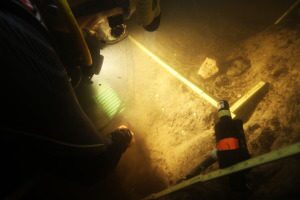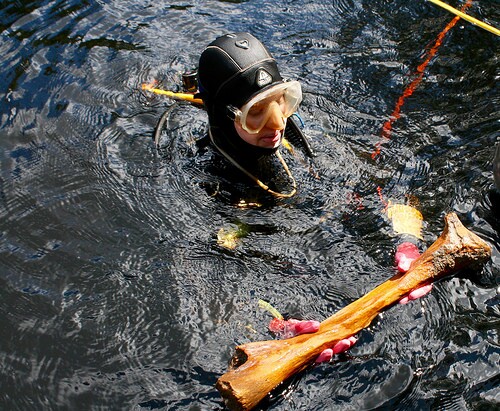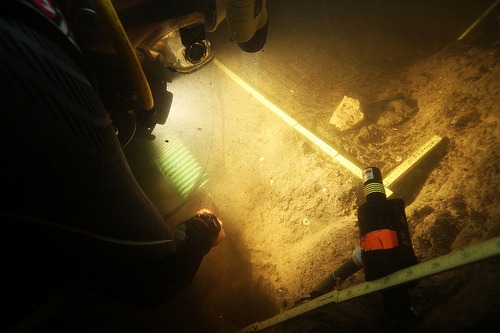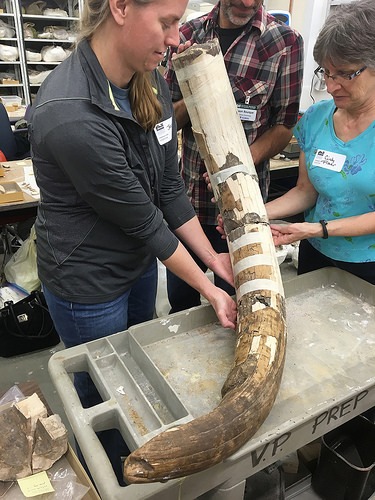
Radiocarbon dating of a prehistoric archeological site in Florida suggests that 14,550 years ago, hunter-gatherers, possibly accompanied by dogs, butchered or scavenged a mastodon next to a small pond. The findings, based on a four-year study of the Page-Ladson archaeological site in the Aucilla River, about 45 minutes from Tallahassee, Florida, provide a rare glimpse of the earliest human occupation in the southeastern United States, and offer clues to the timing of the disappearance of large animals like the mastodon and camel that roamed the American Southeast during the Late Pleistocene. Additionally, the artifacts at Page-Ladson highlight that much of the earliest record of human habitation of the American Southeast lies submerged and buried in unique depositional settings like those found along the Aucilla River, which passes through Florida on its way to the Gulf of Mexico. This record can only be accessed through underwater investigation, which, if undertaken with precision and care, should reveal a rich and abundant pre-Clovis record for the American Southeast, the authors say.
________________________________________
Neil Puckett, a Ph.D. student from Texas A&M University involved in the excavations, surfaces with the limb bone of a juvenile mastodon. Credit: Brendan Fenerty
_____________________________________________________
Divers working underwater at the Page-Ladson site. Image by S. Joy, courtesy of CSFA
____________________________________________________
“This is a big deal,” said Florida State University Assistant Professor of Anthropology Jessi Halligan. “There were people here. So how did they live? This has opened up a whole new line of inquiry for us as scientists as we try to understand the settlement of the Americas.”
Halligan and her colleagues, including Michael Waters from Texas A&M University and Daniel Fisher from University of Michigan, excavated the site, which is located about 30 feet underwater in a sinkhole in the Aucilla River. The site was named after Buddy Page, a diver who first brought the site to the attention of archaeologists in the 1980s, and the Ladson family, which owns the property.
In the 1980s and 1990s, researchers James Dunbar and David Webb investigated the site and retrieved several stone tools and a mastodon tusk with cut marks from a tool in a layer more than 14,000 years old. However, the findings received little attention because they were considered too old to be real and questionable because they were found underwater.
Waters and Halligan, who is a diver, had maintained an interest in the site and believed that it was worth another look.
Working in near-zero-visibility waters in the murky Aucilla River between 2012 and 2014, divers, including Dunbar, excavated stone tools and bones of extinct animals.
They found a biface—a knife with sharp edges on both sides that is used for cutting and butchering animals—as well as other tools. Daniel Fisher, a vertebrate paleontologist at the University of Michigan also took another look at the mastodon tusk that Dunbar had retrieved during the earlier excavations and found it displayed obvious signs of cutting created to remove the tusk from the skull.
The tusk may have been removed to gain access to edible tissue at its base, Fisher said.
Fisher reassembled and re-examined the tusk and concluded that the original interpretation–that the deep, parallel grooves in the surface of the tusk are cut marks made by humans using stone tools to remove the tusk from the skull—is correct.
“These grooves are clearly the result of human activity and, together with new radiocarbon dates, they indicate that humans were processing a mastodon carcass in what is now the southeastern United States much earlier than was generally accepted,” said Fisher.
“Each tusk this size would have had more than 15 pounds of tender, nutritious tissue in its pulp cavity, and that would certainly have been of value,” he said.
Fisher has excavated mammoths and mastodons in North America and Siberia and has personal experience with the practicalities of tusk removal. He once removed a tusk from a juvenile woolly mammoth preserved in Siberian permafrost.
That carcass was in a condition similar to a freshly killed animal, he said. Because he needed to avoid unnecessary damage to the specimen, and because he had to improvise methods and tools to get the job done, it took him about eight hours.
“Compared to ancient hunters, I was a novice,” Fisher said. “But I quickly learned that the most important thing was disrupting the ligament fibers holding the tusk in place.”
Another possible reason to extract a tusk is that ancient humans who lived in this same area are known to have used ivory to make weapons, he added.
“In addition, our work provides strong evidence that early human hunters did not hunt mastodons to extinction as quickly as supporters of the so-called ‘Blitzkrieg’ hypothesis have argued,” Fisher said. “Instead, the evidence from this site shows that humans and megafauna coexisted for at least 2,000 years.”
Despite genetic evidence that people were traveling to the Americas before Clovis, the archaeological record of human habitation in the region between 14,000 and 15,000 years ago is sparse. However, the long-held belief that Clovis represented the first people to enter the Americas is being overturned by new evidence from early sites. The Page-Ladson site is one of just a handful of archaeological gold-mines in the Americas harboring evidence of a pre-Clovis occupation – evidence that has been challenged since researchers discovered the site in the 1980s. So Jessi Halligan, Michael Waters and a team of experts returned to Page-Ladson in 2012 to reevaluate the archaeological evidence that lay undisturbed in the river bed. Using the latest radiocarbon dating techniques, the researchers confirmed the ages of the stone artifacts and mastodon remains to about 14,550 years ago. The artifacts tell the story of what was likely the butchering or scavenging of a mastodon next to a pond in a bedrock sinkhole within the Aucilla River. Evidence from Page-Ladson, along with that from other sites like Monte Verde in Chile, shows that people were living in both hemispheres of the Americas at least 14,550 years ago and confirms genetic predictions for the timing of the arrival of humans into the Americas. Moreover, microscopic tracking of Sporormiella (a fungus often found on animal dung) in sediments at the site, along with other evidence from Page-Ladson sediment samples, indicate that hunter-gatherers along the Gulf Coastal Plain in North America likely coexisted with and used large animals for at least 2,000 years before these animals became extinct around 12,600 years ago.
Texas A&M’s Waters said the Page-Ladson site has changed dramatically since it was first occupied 14,550 years ago. Millennia of deposition associated with rising water tables tied to sea level rise left the site buried under 15 feet of sediment and submerged.
“Page-Ladson significantly adds to our growing knowledge that people were exploring and settling the Americas between 14,000 and 15,000 years ago,” Waters said. “Archaeological evidence from other sites dating to this time period shows us that people were also adapted to living in Texas, Washington, Oregon, Pennsylvania, Wisconsin and South America. Clearly, people were all over the Americas earlier than we thought.”
“The new discoveries at Page-Ladson show that people were [also] living in the Gulf Coast area much earlier than believed,” said Waters.
Added Halligan: “It’s pretty exciting. We thought we knew the answers to how and when we got here, but now the story is changing.”
______________________________________
A Mastodon tusk (partially reassembled) from the Page-Ladson site; curvature is typical for an upper tusk from the left side. Credit: DC Fisher, Univ. Michigan Museum of Paleontology
_______________________________________________
A close-up photo of a biface as found in 14,550-year-old sediments at the Page-Ladson site. Photo by J. Halligan
______________________________________
A schematic showing underwater excavation methodology at Page-Ladson, and location of artifact. Artwork by J.Halligan
______________________________________
Co-principal investigator Michael R. Waters and CSFA student Morgan Smith examining the biface in the field after its discovery. Photo by A. Burke, courtesy of CSFA
_________________________________________________
A biface found in situ at Page-Ladson in 14,550-year old sediments. Image courtesy of CSFA
______________________________________
Assistant Professor Jessi Halligan and a research team recovered several bones and stone tools from the Page-Ladson site on the Aucilla River. Credit: Bruce Palmer/Florida State University
______________________________________________
Details of the discovery and research are published in Science Advances, a publication of the AAAS, a nonprofit society.
Source: Adapted and edited from press releases of Science Advances , Florida State University, and the University of Michigan.
__________________________________________________

______________________________________________
Travel and learn with Far Horizons.
____________________________________________
This richly illustrated issue includes the following stories: Recent findings shedding new light on the whereabouts of the remains of Philip of Macedon, father of Alexander the Great; how an archaeologist-sculptor is bringing bones of the dead back to life; archaeologists uncovering town life at the dawn of civilization; an exclusive interview with internationally acclaimed archaeologist James M. Adovasio about what makes the Meadowcroft Rockshelter prominent in the ongoing search for the first Americans; what archaeologists are finding at the site of the ancient city of Gath, the home town of the biblical Philistine giant, Goliath; and how scientists are redrawing the picture of human evolution in Europe. Find it on Amazon.com.















